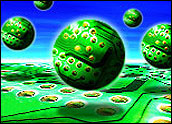
“Quantum levitation” may not be a household term, but one look at a YouTube video now nearing 3 million views, and you’ll soon get the gist of what’s going on.
In essence, it’s a thin but solid disc floating in mid-air.
Magic and science fiction might be what spring to mind, but in fact what’s being demonstrated is real, live science, courtesy of the Superconductivity Group in the School of Physics and Astronomy at Tel Aviv University.
Quantum levitation is the phenomenon behind it, and the term has been on the tip of more than a few tongues ever since the group demonstrated the feat last week at the 2011 Association of Science-Technology Centers (ASTC) Annual Conference.
‘It Becomes a Superconductor’
To make this gravity-defying marvel possible, researchers in a team led by Tel Aviv University physicist Guy Deutscher began by taking a single crystal wafer of sapphire — the familiar gem — and coated it with an extremely thin layer of a ceramic material called “yttrium barium copper oxide.”
“The ceramic layer has no interesting magnetic or electrical properties at room temperature,” the team explains on a dedicated website. “However, when cooled below -185 degrees Centigrade (-301 degrees Fahrenheit) the material becomes a superconductor. It conducts electricity without resistance, with no energy loss. Zero.”
Magnets are the next player to enter the demonstration.
Superconductor vs. Magnetic Tubes
Thanks to something known as the “Meissner effect,” superconductors typically will expel magnetic fields from inside. In this case, however, the superconductor’s extremely thin configuration allows the magnetic field to penetrate in the form of discrete quantities called “flux tubes.”
Superconductivity is destroyed inside each magnetic flux tube, so what results is something of a battle in which the superconductor will try to keep the magnetic tubes pinned in weak areas.
“Any spatial movement of the superconductor will cause the flux tubes to move,” the researchers explain.
In its effort to prevent that from happening, the superconductor remains “trapped” in mid-air in a state known as “quantum levitation,” as the researchers’ own video also demonstrates.
‘Not Surprising Scientifically’
As a “variation of the well-studied superconductor Meissner effect,” the demonstration of quantum levitation is “educational but not surprising scientifically,” Jeanie Lau, an associate professor in the Department of Physics at the University of California at Riverside, told TechNewsWorld.
There are actually numerous videos on YouTube demonstrating something similar, as a simple search on “Meissner effect” will illustrate, Lau pointed out.
“The underlying principle is that a superconductor repels magnets, so much so that it ‘refuses’ to let the magnet get close, hence causing the magnet to float over the superconductor disk,” she explained.
The Maglev Train
With such a compelling demonstration right before one’s very eyes, it’s tempting to imagine Jetsons-style vehicles and all kinds of other levitating objects that could be useful in real life.
And indeed, Japan has used similar superconductor levitation in Maglev, or “magnetic levitation,” trains to achieve super-high speeds, Lau pointed out.
It may be a while, however, before innovations based on technology like that used in the Israeli researchers’ most recent demonstration become possible — at least here on Earth.
‘A Number of Hurdles To Be Overcome’
“Since the discrete flux tubes depend on deep cooling, it would be practical only in an already cooled environment like outer space or a planet like Neptune,” Roger Kay, founder and president of Endpoint Technologies, told TechNewsWorld.
“However, in those environments, it could provide frictionless transport, assuming it could scale and magnets could be made cheaply,” Kay added. “So, there are a number of engineering hurdles to be overcome before quantum levitation could be used in a practical setting.”






















































Hello my name is Zachary Maneja age:14
I still have a lot of research to do but I may have a way to make a hoverboard, I probably have a lot of learning, research and profit I need to make, but I`m not stopping to open the doors of a new generation. If you want to give me help or give me tips let me know maybe I could use it in the making. My love for Science is high and nothing will make me hate it, I`m grown up and mature so I try to make as accurate and mature explanations as possible and I have a note book of possibilities. Thank you for taking time reading this and get ready for a new generation
Email:
[email protected]